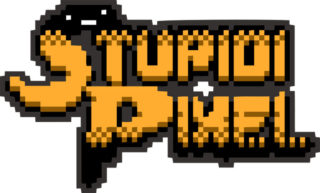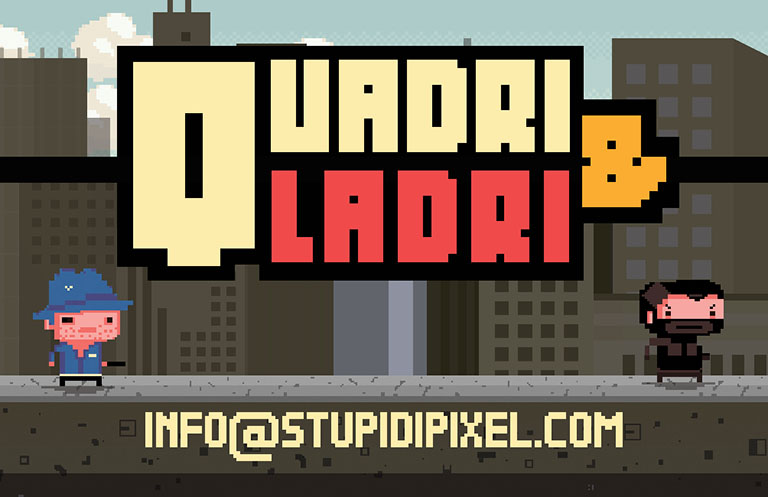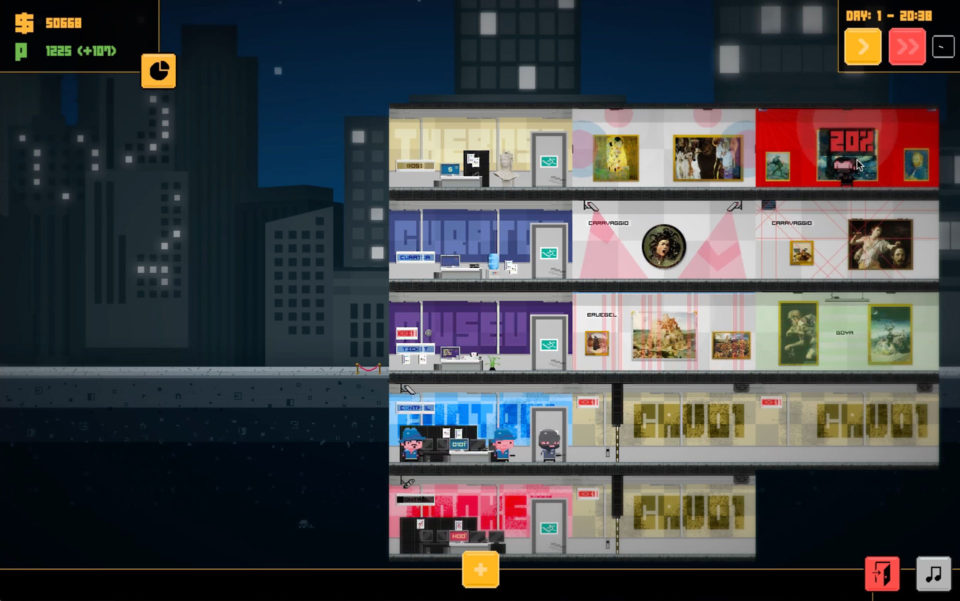Stupidi Pixel and their game Paintings & Thieves was recognized at Milan Games Week Indie, which is ran by the AESVI. This means that the team will be able to show Paintings & Thieves at Casual Connect Europe and Indie Prize and represent the Italian development scene internationally. Milan Games Week Indie is a partner event with Casual Connect.
“It was a big acknowledgment for the hard work put into this project. Also, it was an important boost of confidence since Paintings & Thieves is just our first game as a team, so it means we have started in the right direction and, hopefully, we can grow and get better,” said Fabio Taurisano, Producer at Stupidi Pixel. “We are humbled by the judges’ decision… we totally did not expect Paintings & Thieves to win! We’ll give our best to represent the Italian community at the event.”
Pixelated Paintings
Fabio says that Stupidi Pixel gave Paintings & Thieves a pixel art style because they love those sorts of games. They also wanted to do a museum theme because it’s under explored in video games and fits the two main phases of the game.
“Design wise we believe that a series of ups and downs, a rollercoaster of decisions so to speak, is the best way to make the player feel engaged and care about what is happening inside the game,” said Fabio. “Hence we decided to have a more relaxed, management oriented day-phase, counterposed by a more action-ish night. However the game is still wildly evolving and both gameplay-types are bound to change, there’s still some things we’ll unveil in the future.”
Working Hard Because They Want To
Stupidi Pixel is a virtual studio, though they meet in-person frequently. They do plan on a real studio though if they become a formal company, describing the experience as being their dream.

After being asked about their work culture, Fabio said, “We work when we want. We play together. We go out together. We have fun. And sometimes we also make the games you’ll play. It’s all very open-minded and inspiring. Everyone in our team creates because he WANTS to, not because of some management imposed strict timeline. So we’ll have people working nights because THEY really want to see a feature inside the game. Aaaawesome!”

Fabio says that they work together to get through any problems that come up, so nothing terribly painful has happened to them. This team spirit translates to testing as well.
“For Quadri & Ladri we never test enough. I mean… the game works right? We try to be very diligent without coding so that bugs don’t arise in the first place. But bugs happen,” detailed Fabio. “Being only four people testing would mean losing a lot of time that could be better spent in development. That is unfortunately a harsh reality of the indie scene. However that is no excuse for many of the horror stories you hear regarding Early Access titles these days. We will never release a game if we don’t feel it’s in a playable state and, most importantly, an enjoyable experience.”


“In a perfect scenario we would like to test each time we add a new feature, but actually… we often don’t find the time to do so. Because of that we end up trying out a set of new features all together…” said Fabio.
“The day before any big event,” notes developer Simone Di Gravio.
“We are currently in contact with some trustworthy people that will perform testing and report bugs for us,” continued Fabio.
“We use the events we take part in as a way to do play tests,” added developer Antonio Umberto Aramini. “I think the most interesting reaction was from a middle-aged man that finished the demo version without any input from us and with extreme dedication. At the end he also highlighted the balancing issues when entering middle-end game.”
“Play tests? I know I’ve seen some dead thieves escape. And that’s a feature,” joked Simone.
WoodStock Simulator 2016
When asked about what games they would make if they had unlimited resources, the team had varied and interesting responses.
“The game I’d like to create is the ultimate Pokémon game: all catchable species, all regions, all gym leaders and so on,” said Antonio. Basically the whole world should be explorable (and dangerous!) as in a real adventure and without constraints on the path to take in order to proceed (e.g. you can visit a region before another if you wish and vice-versa). Freedom should be the key principle in a game like this. I should probably get in touch with Nintendo and Game Freak.”
“Oh man… too many! I’ll definitely work on some of these in the future. I’ll have Antonio help me for sure too,” said Simone. “Right?!”

“I’d love to make a horror game where being caught by ‘the killer’ does not equate to the end of the game. Maybe he’ll attack you; you’ll lose a limb and consequently the ability to approach certain situations in the most common way… You’ll have to find a way around your new handicap. It would create interesting narrative arcs if well done,” described Simone. “Or… I’ve always hated how pretty much nothing in MMOs is really unique. That super duper cool sword you got? The other half of the server has it too. You are NOT unique. There’s no real deep resource management in today’s MMOs, apart from Eve maybe. I’ve always liked Monster Hunter and the idea of expanding it by having an open world with a balanced ecosystem where resources are limited strikes me as extremely rewarding both in terms of designing the game as well as experiencing it. Level design wise, the placement of resources could give life to interesting intra-servers situations where maybe the only available gold is in the nest of the most powerful beast of the game. Players would need to collaborate… or maybe a black market would rise, who knows?”
“A VR WoodStock Simulator,” said a smiling Fabio.

Live and Design
Talking to Stupidi Pixel, they seem to have a very lose structure for the way they handle development. For example, they don’t have a designated director, keeping the structure flat during all phases of development.
“The creative process goes something along these lines: someone comes up with an idea he likes and thinks will benefit the game, brings it up with the team, then brainstorming around that specific idea happens. The idea gets passed around our beautiful minds and comes out as something new and shiny and fun. And that, kids, is how I met a new game mechanic,” said Fabio. “Feedback from playtesters are then of uttermost importance for balancing the game and correct any rough edges that might impact the experience.”

One of those inspired decisions was going with pixel art for the game. “We really like pixel art and we acknowledged that it is particularly on point for this game,” detailed Fabio. “We were really lucky because the art style didn’t change during the development of the title. It’s possibly the best decision we took for the game.”
Make Games for Love, Not Money
Stupidi Pixel is just starting their journey as developers, so much so they’re not sure what they’ll do next, but it will probably be on smartphones or PC (and consoles, if they get the chance). Despite just taking their first steps into a larger world, the developers had some words of wisdom for other indie developers.
“Don’t bite more than you can chew. You can almost always add new features, create better graphics, implement new mechanics at a later time. Focus on what you can achieve in the short term (maybe having a wishlist of stuff you’d like to put in the game later if possible) and get your core gameplay loop up and running as soon as possible,” noted Fabio. “See if that works; if it conveys what you want players to experience when they try your game. A five minute demo is all you really need to understand if your game can be interesting.”

“I personally suggest Fumito Ueda’s approach: Design by Subtraction,” added Simone. “A very interesting video by Mark Brown can be found here.”
While the developers at Stupidi Pixel are a bunch of fun loving guys (they joked about a “Giant Enemy Crab” being in their game) they immediately switched to talking about how important it was to make sure there aren’t “super-intrusive ads” inside their games. They want their game to be played by as many people as possible, and while they haven’t decided on how they’re going to monetize Paintings & Thieves, making games is all about love for them.
“Don’t make games for money. Create because you love giving birth to experiences people will want to share,” concluded Fabio.
Comments











